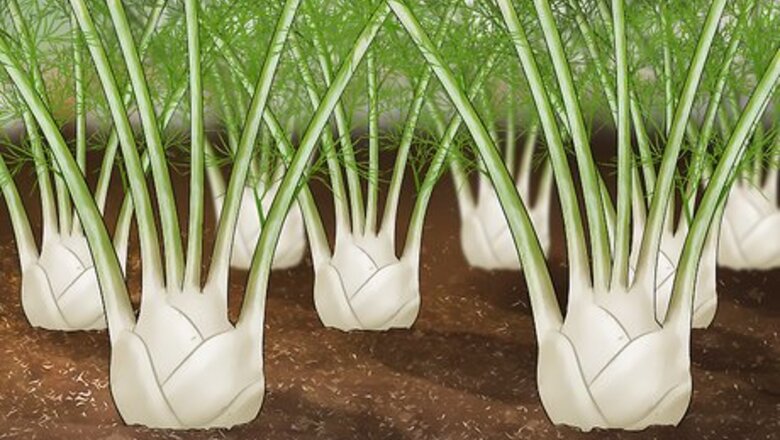
views
X
Research source
Finding Butterfly Eggs
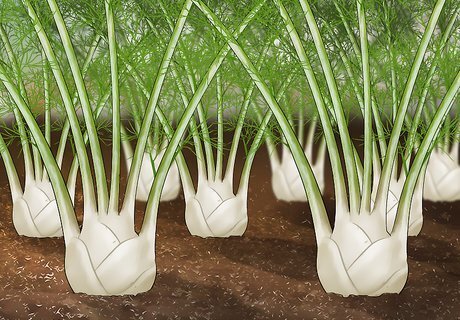
Keep host plants such as dill and parsley in your garden. Black swallowtail butterflies lay their eggs on the leaves of dill, fennel, parsley, and rue. These plants can easily be found at your local garden center or nursery. The plants provide food for the caterpillars once they hatch from their eggs. Different host plants may grow better in different areas. If your host plants don't seem to be growing well, ask around at your local nursery or farmer's market to find out which plants grow the best where you live.

Plant nectar plants such as red clover to attract butterflies. Butterflies get their food from the nectar of flowers. Flowering plants that are favorites of the black swallowtail, such as milkweed, flox, red clover, and thistle, will attract these butterflies to your garden. Placing your nectar plants close to your host plants will encourage the butterflies to lay their eggs there.

Locate black swallowtail eggs on the leaves of host plants. Black swallowtail eggs are tiny yellow or golden orbs. The butterflies lay their eggs on the tops of the leaves, so they should be relatively easy to spot. Female black swallowtail butterflies lay between 200 and 400 eggs, at the rate of 30 to 50 a day. So don't expect to only see a few – you'll likely see dozens. Check your plants frequently for pests. Ladybugs, wasps, and spiders will eat butterfly eggs if they find them before you do. Keep in mind that spraying your plants with pesticides will likely harm the butterflies as well.Tip: You may see clear or white spheres the same size as butterfly eggs. These are empty eggshells leftover after the egg has been consumed by predators.

Snap off the part of the plant with eggs on it. When you've found eggs, don't try to remove them from the plant. Instead, gently snip off the plant along with the eggs and carry it inside. You'll typically find multiple eggs on a single leaf or branch. Go ahead and transfer all of the eggs together – especially since some of them likely won't hatch. You also have the option of waiting until the eggs have hatched and adopting a caterpillar instead. This may eliminate some of the guesswork of whether or not the eggs will hatch.
Creating a Caterpillar Home

Find a large jar that will hold the piece of the plant with eggs on it. Your caterpillar isn't picky when it comes to the container you place it in. Any jar or plastic bin will work fine – just make sure you use something you can see through so you can watch the caterpillar hatch from its egg and go through its 5 stages of growth. At this stage, you can close the lid or seal the container. This will help keep the eggs from being disturbed by outside elements. The egg stage lasts between 4 and 10 days. The eggs will turn dark gray or black before they hatch.

Provide fresh air once the eggs hatch. When the eggs hatch, you'll see tiny black creatures on the leaves instead of eggs. At this point, remove the lid from the container and cover it with mesh or a paper towel to allow fresh air to get in. Don't worry about the size of the mesh – your caterpillars won't escape. They're far more interested in eating the food that's available for them. Don't expect all the eggs to hatch. Only about 1 out of every 100 black swallowtail eggs makes it through all the life stages to become a butterfly.

House your caterpillars in a large jar or plastic container. If you're keeping the caterpillars inside, you have many different options to house and protect them as they grow. Make sure you choose one that allows you to watch the caterpillar as it goes through its life stages. A large jar or plastic container is fine for a single caterpillar – just make sure it has enough height that you can keep a vertical branch for the caterpillar to hang its chrysalis when it gets to that stage. If you have multiple caterpillars, you can also use an aquarium or even a reptile cage.

Feed your caterpillar fresh host plant cuttings daily. Black Swallowtail caterpillars eat a lot. Make sure there are plenty of cuttings in the caterpillar enclosure. Generally, you want to use the same plant where you originally found the caterpillar's eggs. You can experiment with other plants as well. Black Swallowtail caterpillars eat dill, fennel, parsley, and rue. Especially in the later stages of development, caterpillars typically become less picky about what they eat. Some caterpillars may eat plants that you bought in a grocery store, but this generally isn't a good idea. The plants may have been treated with pesticides that could harm your caterpillar, and you wouldn't have any way of knowing until it was too late. Black swallowtails remain caterpillars for 3 to 4 weeks. If your caterpillar stops eating after 3 or 4 weeks, that's typically a sign that it's about to make a chrysalis.Tip: Although it's technically safe to touch or hold a black swallowtail caterpillar, it may not be the best idea. They are very delicate. Additionally, when disturbed, a bright orange, 2-pronged fork will emerge from behind its head. This osmeterium emits an unpleasant smell, similar to rotten cheese, as a defense when the caterpillar is disturbed.

Include a branch for the caterpillar's chrysalis. When your caterpillar reaches its final stage of growth, it will make a chrysalis off of a branch. The chrysalis will hang from the branch in the open air, attached by silk threads the caterpillar creates. It doesn't have to be a particularly large branch – however, it does need to be sturdy enough to support the caterpillar. If your caterpillar can walk from one end of the branch to the other, it should be fine.
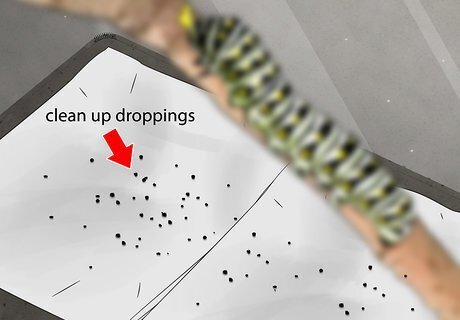
Clean the caterpillar droppings at least once a day. Since caterpillars eat a lot, they also generate a lot of waste. If you don't clean your caterpillar's enclosure at least once a day, you'll start to have a pretty stinky mess. You can try placing the caterpillar in a jar or vase, then gently turning the jar or vase upside down on a sheet of newspaper. The droppings will fall on the newspaper and can be easily disposed of. Then all you have to do is replace the newspaper. Make sure your caterpillar is clinging to a leaf or branch when you turn it over. Your caterpillar will outgrow its skin and molt 5 times. They typically eat the molted skin, but you may also need to clean remnants from the bottom of the caterpillar's enclosure.

Watch for signs that the caterpillar is ready to form a chrysalis. When your black swallowtail caterpillar is ready to form a chrysalis, it will stop eating. You'll see it curl its head under its body, so it looks like an upside-down "J." If you look closely, you'll also see a silk button and belt forming. These threads are used to secure the chrysalis to the branch while the caterpillar completes its transformation into a butterfly. Once the caterpillar is attached to the branch, it will hang there for about 24 hours before shedding its skin to reveal the chrysalis.
Releasing the Butterfly

Clear space in the enclosure for the butterfly to emerge. After your caterpillar forms a chrysalis, it will hang for 1 to 2 weeks. The butterfly needs to be able to hang from the branch with its wings down. Remove any branches or cuttings crowding the area around the chrysalis, so the butterfly will have room to hang and stretch its wings without injury. Since the caterpillar in its chrysalis isn't going to eat anything, you can also remove extraneous cuttings or other materials from the enclosure. Don't handle or attempt to move the chrysalis – you could kill the creature inside.
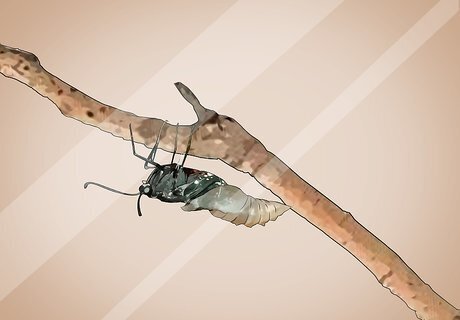
Wait for the butterfly to emerge from the chrysalis. Within a couple of weeks, the chrysalis will turn dark, then become clear as the black swallowtail butterfly emerges. It may take a few minutes or even a few hours for the butterfly's wings to harden. When they start to gently flutter, your butterfly is ready to fly. A black swallowtail butterfly typically emerges from its chrysalis in the early morning hours, just after sunrise.
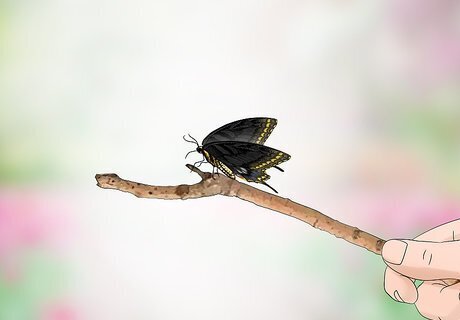
Carry the butterfly outside on a stick or potted plant. Some black swallowtail butterflies will fly straight out of an open jar or vase, but others need a little more prodding to take wing. You can gently take out the stick the butterfly is resting on and carry it outside. If you take the whole enclosure outside, simply set it down in a sunny spot and wait for the butterfly to take to the air. Don't shake or tap on the enclosure – you'll disturb the butterfly and could injure it. You can also see if your butterfly will come to rest on your hand, but be careful not to touch its wings. They are fragile and you could injure the butterfly without even realizing it.Tip: Although some people like to keep the butterfly as a pet, this isn't the kindest thing for the butterfly. Black swallowtail butterflies only have a lifespan of 2 to 4 weeks, so it's better to let it enjoy its freedom.




















Comments
0 comment